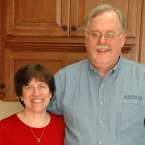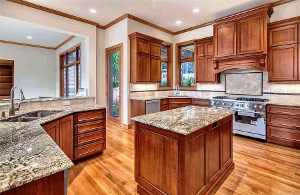Carl Spencer, owner of Spencer Cabinetry, Monroe, WA, shared the transcript of his September 2013 testimony before the International Trade Commission regarding the Chinese Plywood dumping case.
UNITED STATES INTERNATIONAL TRADE COMMISSION
HARDWOOD PLYWOOD FROM
Inv. Nos. 701-TA-490THE PEOPLE’S REPUBLIC OF CHINA
and 731-TA-1204 (Final) FINAL HEARINGSEPTEMBER 19, 2013
Testimony of Carl Spencer, Co-Owner, Spencer Cabinetry
 My name is Carl Spencer. Forty years ago this past April I got a job running a panel saw for Armstrong Cabinets in Ottawa, Kansas. While I was there, I mastered every cabinetmaking task on the shop floor and every business task in the office.
My name is Carl Spencer. Forty years ago this past April I got a job running a panel saw for Armstrong Cabinets in Ottawa, Kansas. While I was there, I mastered every cabinetmaking task on the shop floor and every business task in the office.
Since that time, I have been recruited several times throughout the industry, managing plants for tiny Draper DBS, middle size Omega Cabinets, and Masco, the very largest cabinet manufacturer at that time.
Eight years ago last week, my wife and I took our shot at the Great American Dream and started Spencer Cabinetry from our life’s savings, with just the two of us as its only employees. Despite the recession we grew and steadily created jobs.
We are very proud of our company and our 15 employees. Over the last eight years we have maintained one of the fastest growth rates in North America, currently approaching $2.0 million in sales.
The kitchen cabinet industry overall is currently almost a $9 billion dollar industry which has a very low barrier of entry and is therefore highly fragmented. Roughly one-third of the U.S. cabinet market is controlled by seven companies (including Norcraft), but 60% of the industry is made up of approximately nine thousand companies like mine, all under $15 million per year. We are, in fact, the backbone of our industry, both in terms of aggregate revenues and aggregate jobs.
 Small cabinet companies like mine struggle for existence every single day. We cannot afford attorneys to plead our case, let alone lobbyists. While we’re awake, we’re either selling cabinets or making them with our own hands, putting bread on the table for our employees and ourselves the old-fashioned way. This daily imperative is why this room is not overflowing with many more from my 60% of our industry, whose predicament I now must represent.
Small cabinet companies like mine struggle for existence every single day. We cannot afford attorneys to plead our case, let alone lobbyists. While we’re awake, we’re either selling cabinets or making them with our own hands, putting bread on the table for our employees and ourselves the old-fashioned way. This daily imperative is why this room is not overflowing with many more from my 60% of our industry, whose predicament I now must represent.
Let me explain. Virtually all of us use both domestic and Chinese plywood just like the big boys, and generally in the same way.
For as long as I have been in the industry, domestic hardwood plywood has been conventionally used as the primary wood. The veneers not only look better, there is less unsightly telegraphing of the underlying veneers, and virtually no voids or depressions. In addition, the face veneers are substantially thicker, permitting appropriate sanding for the best finished surface on the completed cabinet. This great appearance on the outside is what attracts customers.
Imported plywood has always been relegated for use as secondary wood. This is not a recent phenomenon -- it was true forty years ago when I started on that panel saw, and it remains true today. Imports look adequate for structural interior parts where imperfections are not critical, and that’s about it. This prudent economy is what makes cabinets saleable to the general public.
No one in the cabinet industry would confuse the two types of materials just because they both come in 4x8 sheets and have a hardwood veneer face.
Even the HPVA has noted these distinct quality differences between domestic and imported plywood in their arguments. The key is “fitness of use.”
You see, Chinese hardwood plywood was never a substitute for domestic hardwood plywood. Chinese plywood as a secondary wood is a substitute for particle board or thin panels from other import sources. Pretending domestic plywood will now be purchased in place of Chinese plywood for secondary wood applications simply defies logic.
The capacity limits of domestic plywood companies will create shortages and drive the domestic prices up. Whose orders get filled first when there are shortages? Not the small guys like me!
As the duty for Chinese plywood drives up all hardwood plywood prices, most of my small business peers will be forced to go to particle board interiors, wiping out our unique market differentiation and forcing us to compete head-on with the very biggest stock cabinet producers (who primarily use particle board) and their overwhelming economies of scale.
Domestic plywood manufacturers will not get the additional business they hope for. The American consumer will only be offered a choice between cabinets with lower quality and less water-resistant material, or cabinets too expensive to buy. The cabinet industry as a whole will be driven towards consolidation, wiping out a high percentage of small cabinet shops like mine.
Remember us? We’re 60% of U.S. cabinet production, 60% of U.S. cabinet jobs, and more than 60% of the innovation and job creation. More cabinet jobs are at risk of disappearing than plywood jobs that could possibly be created. Please, please remember us when you are making your decision.
After all, it is the domestic cabinet and furniture companies that buy all that hardwood plywood, especially the smaller cabinet manufacturers. If we’re priced out of business, who is going to buy all that American-made hardwood plywood, even for primary wood?
It gets worse. The new duties won’t punish the Chinese plywood factories one iota. They will merely shift their output away from American cabinet companies towards rapidly expanding cabinet companies in China, Canada, and Mexico, among others.
From our point of view, our own government’s actions amount to a de facto stimulus, not for Americans, but instead for the Chinese, Canadian, and Mexican cabinet industries -- all of whom can still buy plywood from China at the true world price. In the end, it is the American cabinet companies that will be punished, especially the small ones, and American jobs that will be lost.
From where I stand in Washington State, the economy is starting to come back. More houses are being built, and our sales are already up more than 40% over last year. We’ve hired more people and are currently continuing to hire.
And as our sales volume increases, we’re buying significantly more of both domestic and Chinese hardwood plywood already. Most of the 60% of the U.S. cabinet industry I represent are also growing stronger and buying more of both types of plywood. Why would anyone in this room want to artificially interfere with this process when we will all benefit more by letting Nature take her course?
Thank you for your time.



Have something to say? Share your thoughts with us in the comments below.